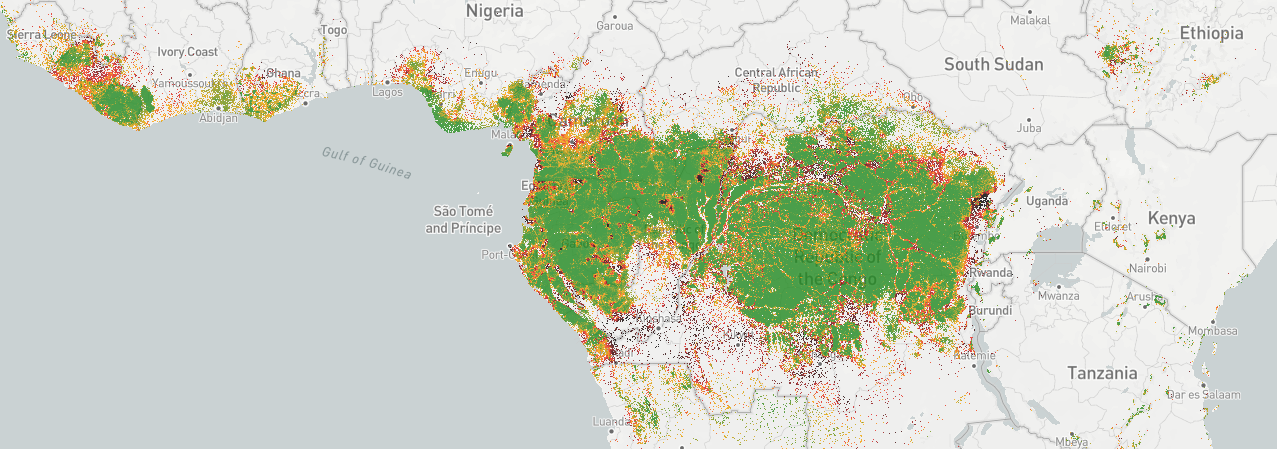The forestatrisk Python package can be used to model and
forecast deforestation in the tropics. It provides functions to
estimate the spatial probability of deforestation as a function of
various spatial explanatory variables.
Spatial explanatory variables can be derived from topography (altitude, slope, and aspect), accessibility (distance to roads, towns, and forest edge), deforestation history (distance to previous deforestation) or land conservation status (eg. protected area) for example.

You will need several dependencies to run the forestatrisk Python
package. The best way to install the package is to create a Python
virtual environment, either through conda (recommended) or virtualenv.
You first need to have miniconda3 installed (see here).
Then, create a conda environment (details here)
and install the forestatrisk package with the following commands:
conda create --name conda-far python=3.7 gdal numpy matplotlib pandas patsy pip statsmodels --yes
conda activate conda-far
conda install -c conda-forge earthengine-api --yes
pip install pywdpa sklearn # Packages not available with conda
pip install forestatrisk # For PyPI version
# pip install https://github.com/ghislainv/forestatrisk/archive/master.zip # For GitHub dev version
# conda install -c conda-forge python-dotenv rclone --yes # Potentially interesting librariesTo deactivate and delete the conda environment:
conda deactivate
conda env remove --name conda-farYou first need to have the virtualenv package installed (see here).
Then, create a virtual environment and install the forestatrisk
package with the following commands:
cd ~
mkdir venvs # Directory for virtual environments
cd venvs
virtualenv --python=/usr/bin/python3 venv-far
source ~/venvs/venv-far/bin/activate
# Install numpy first
pip install numpy
# Install gdal (the correct version)
pip install --global-option=build_ext --global-option="-I/usr/include/gdal" gdal==$(gdal-config --version)
pip install forestatrisk # For PyPI version, this will install all other dependencies
# pip install https://github.com/ghislainv/forestatrisk/archive/master.zip # For GitHub dev version
pip install statsmodels # Optional additional packagesTo deactivate and delete the virtual environment:
deactivate
rm -R ~/venvs/venv-far # Just remove the repositoryYou can test that the package has been correctly installed using the
command forestatrisk in a terminal:
forestatriskThis should return a short description of the forestatrisk package
and the version number:
# ForestAtRisk: Modelling and forecasting deforestation in the tropics.
# https://ecology.ghislainv.fr/forestatrisk/
# ForestAtRisk version 0.2.You can also test the package executing the commands in the Get started tutorial.
Function .sample() sample observations points from a forest cover
change map. The sample is balanced and stratified between deforested
and non-deforested pixels. The function also retrieves information
from explanatory variables for each sampled point. Sampling is done by
block to allow computation on large study areas (e.g. country or
continental scale) with a high spatial resolution (e.g. 30m).
Function .model_binomial_iCAR() can be used to fit the
deforestation model. A linear Binomial logistic regression model is
used in this case. The model includes an intrinsic Conditional
Autoregressive (iCAR) process to account for the spatial
autocorrelation of the observations. Parameter inference is done in a
hierarchical Bayesian framework. The function calls a Gibbs sampler
with a Metropolis algorithm written in pure C code to reduce
computation time.
Other models (such as a simple GLM or a Random Forest model) can also be used.
Function .predict() allows predicting the deforestation
probability on the whole study area using the deforestation model
fitted with .model_*() functions. The prediction is done by block
to allow the computation on large study areas (e.g. country or
continental scale) with a high spatial resolution (e.g. 30m).
Function .deforest() predicts the future forest cover map based on a
raster of probability of deforestation (rescaled from 1 to 65535),
which is obtained from function .predict(), and an area (in
hectares) to be deforested.
A set of functions (eg. .cross_validation() or
.map_accuracy()) is also provided to perform model and map
validation.
The forestatrisk Python package is Open Source and released under
the GNU GPL version 3 license. Anybody who is interested can
contribute to the package development following our Community
guidelines. Every contributor must agree to
follow the project's Code of conduct.


